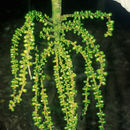pt-BR
nomes no trilho de navegação


Iriartea deltoidea is a large canopy palm belonging to the Aracacea family. It is found in both primary and secondary forests throughout the lowland forests of Central and Southern America, from Nicaragua to Bolivia and the western Amazon region of Columbia, Venezuela, and Brazil (Kessler, 2000; Trudgen 2013). The palm produces 1-3m long inflorescences of creamy yellow flowers which are pollinated by bees. The fruits are 3cm drupes that are eaten and dispersed by toucans, monkeys, and other birds and mammals.
Iriartea deltoidea is considered Neotropical, occurring from Nicaragua south to Bolivia and into the western Amazon region of Columbia, Venezuela, and Brazil. I. deltoidea is found evenly from sea level to 1300m elevation at its highest (Kessler, 2000).
Iriartea deltoidea is found from the slopes of the Andes mountains to stream banks of lowland forests, and can be found in all major habitats from swampy soils to terra firme and mature floodplains (Terbourgh and Putz, 2001). It is found equally in primary and secondary forests, as well as in forest-agriculture mosaics (Anderson and Davenport, 2001).
Iriartea deltoidea is one of the most common palm species found in lowland forests (Kessler, 2000). It is a canopy palm, growing to between 20m and 30m, slowly and steadily. The leaves are pinnately compound and fan-shaped, with a new leaf produced each month. Inflorescences are also produced once a month, and take the form of a 1-3m spathe surrounding an equally long spadix of creamy yellow flowers. After pollination by Trigona bees and a few other species of bees, a branched infructescence forms. The fruit first begin to be produced in June and continue in the immature stage until December. Mature fruits were observed between October and April (Peres, 1994). The fruit are 3cm bluish-black drupes, and are dispersed by toucans, monkeys, and other birds and mammals, while peccaries, rodents, and red and grey brocket deer are seed predators (Henderson et al., 1995). Seed predation is density dependent, and high in most habitats of Iriartea deltoidea due to high density of I. deltoidea individuals relative to other species (Wyatt, and Silman 2004). Due to high density of individuals, increased movement by seed predators such as peccaries can increase compaction of soil and trampling of seedlings surrounding I. deltoidea (Queenborough et al., 2012).The roots grow in a dense stilt cone at the base of the stem, up to 1.5m off of the ground, and have prominent lenticels (Avalos et al., 2005). The root tips are capped before reaching the ground, allowing them to more easily penetrate swampy or clay-dominant soils.
As a monocot, Iriartea deltoidea does not form a true trunk. However, the woody stem is strong enough to be used in producing furniture and handcrafts (Anderson and Putz, 2002). While the furniture produced from I. deltoidea trunks is too heavy for cheap transport, economies in small cities in both Ecuador and Bolivia have sprung up centered around local production and purchasing of I. deltoidea furniture and products.
Iriartea is a genus in the palm family Arecaceae, native to Central and South America. The best-known species – and probably the only one – is Iriartea deltoidea, which is found from Nicaragua, south into Bolivia and a great portion of Western Amazonian basin. It is the most common tree in many forests in which it occurs.
It is known by such names as bombona (which can also refer to other palms, e.g. Attalea regia) or cacho de vaca (which can refer to many other plants, like the Bignoniaceae Godmania aesculifolia or the orchid Myrmecophila humboldtii). In the Murui Huitoto language of southwestern Colombia, it is called jɨagɨna or jɨaìgɨna,[2] in western Ecuador it is known as pambil, and in Peru it is known as the pona palm.
These palms are canopy trees growing to 20–35 m tall. I. deltoidea is easily recognized by the prominent bulge in the center of its trunk, and the stilt roots, which form a dense cone up to 1 m in diameter at the base. It can thus be easily be distinguished from Socratea exorrhiza (which also bears stilt roots), as the stilt roots of the former are much less tightly appressed upon one another. The leaves are up to 5 m long, and pinnate. The numerous pinnae are fan-shaped, and held in various planes. The fruit is a 2-cm diameter drupe, and primarily dispersed by bats and toucans.
Toucan foraging behavior can have quite distinct signature in young second-growth forest regeneration. In certain cases seedlings growing around a mature fruiting Iriartea palms may actually come from dozens of different trees hundreds of meters away.[3]
The fruit are also eaten by humans, and the wood is used for construction and in handicraft.[2]
Iriartea timber is highly prized for housing, furniture, and tools. Various South American countries, including Ecuador, export Iriartea wood to the United States.[4]
Almost all species at one time placed in Iriartea have now been moved elsewhere or placed in synonymy with I. deltoidea. Dictyocaryum, Iriartella, Socratea and Wettinia were split off from the Iriartea but are close relatives, together with the present genus forming the tribe Iriarteeae. Less closely related palms which were at one time presumed to be Iriarteeae are members of the genera Ceroxylon, Drymophloeus, and the monotypic Deckenia nobilis.[1]
There remain a few somewhat dubious taxa, published in L'Illustration Horticole in 1881. These may be synonyms or good species, but probably the former:[1]
Iriartea is a genus in the palm family Arecaceae, native to Central and South America. The best-known species – and probably the only one – is Iriartea deltoidea, which is found from Nicaragua, south into Bolivia and a great portion of Western Amazonian basin. It is the most common tree in many forests in which it occurs.